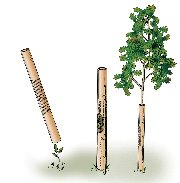
(Spoiler: Don't anyone ever tell me again that growing great trees in the urban environment won't work with tree tubes! It works and it works great)
Back in the early 90s we were experimenting with planting seedling trees in all sorts of locations using a tree tube to nurture and protect tender seedlings. I will be covering more examples in the weeks to come.
Some applications we just "knew" were doomed. One was a planting of native trees at
Central High School in Saint Paul, Minnesota. The school has a long history. Famous grads include Charles Schutz of Peanuts fame and David Winfield the Hall of Fame ball player.

Some thought the planting would be a "feel good" exercise, but obviously the tree tubes would get run over by the kids. Here is what our experiment looks like today. Up against the build is an oak grove. The trees are absolutely fantastic. The trunks are thick and straight and tapered. These trees have not had any special care.
Grass grows up to the base of the tree. There is no mulch. No bark. No chips. No mats. I wish there were, but there is not.
Why plant bur oak in the city? My home in Saint Paul is not too far from here. There is a wild bur oak in my back yard I date to around 1850. In 1981 we removed a 114 year old limb that was ten feet up. These old (young by bur oak standards) trees are all over St. Paul.
Before the streets were laid out I think St. Paul was more or less a bur oak savannah. I love these old bur oaks. They survived and may have been aided by the brush fires that hit the area after all the trees were cut to support
Fort Snelling. The white tail deer range was south of here when these trees were seedlings, so unlike modern oaks deer browse was not a problem.

The St. Paul bur oaks survived development. Five lived on our block when we moved here in 1981. Four remain. The largest and nicest was cut down because it had been defoliated once and the owners mistakenly thought it was dead. Bur oak is tough and a healthy tree can
survive several defoliations.
Lets take a closer look at the CHS bur oak. Wow. Those trees look terrific. Beautiful trunks. Straight trunks. Yes, bur oak has a few
epicormic branches, but that is normal.

If you look at the base of the tree on the left, you will see the remains of an old style Tubex treeshelter.
These tubes were left in place for at least seven years and maybe more. I'll try to find out how long. By the way, while we want you to leave the tubes on for protection as long as ten years, you should remove the tube before the trunk swells to fill and crack the tube.
I repeat, don't ever tell me tree tubes won't work in the urban forest. Tree tubes work and provide an incredible value.
The usual knock is vandalism. Look at the pictures above. If seedlings in tree tubes survive and thrive at my local high school, where won't they work? Vandalism is a fact of life, so would you rather lose a $200 B&B or a $20 seedling and tube? Your choice.
The other objection is visual impact. Plant a quality seedling in a Plantra four foot vented tree tube surrounded by mulch and you will have eye level foliage in 2-3 months. If you can delay gratification to the end of the summer, we can establish trees at 1/10th the cost of B&B.
So don't tell me it won't work and don't tell me it doesn't make sense.
America is under-planted and with emerging pathogens such as emerald ash borer getting more under-planted everyday. Plantra tree tubes will get the job done fast and at the lowest cost.
Let's start planting seedlings in our cities.
 June 12, 9:25 pm
June 12, 9:25 pm June 14, 5:56 am
June 14, 5:56 am June 15, 10:43 pm
June 15, 10:43 pm June 16, 8:19 pm
June 16, 8:19 pm I'd love to be able to claim that we are such good deer trackers that we surveyed 1 mile of hedgerow and picked the exact spot deer pass through most frequently. Fact is, we took a guess. I'm not even going to say we got lucky; I have a hunch we'd capture this many deer on film anywhere we put the cameras.
I'd love to be able to claim that we are such good deer trackers that we surveyed 1 mile of hedgerow and picked the exact spot deer pass through most frequently. Fact is, we took a guess. I'm not even going to say we got lucky; I have a hunch we'd capture this many deer on film anywhere we put the cameras. 







